|
|
|
Sort Order |
|
|
|
Items / Page
|
|
|
|
|
|
|
| Srl | Item |
| 1 |
ID:
161340
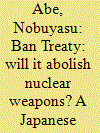

|
|
|
|
|
| Summary/Abstract |
In so far as the nuclear-weapons possessors do not accept the Ban Treaty, practically it will not reduce nuclear weapons nor abolish them as a matter of law. However, if the treaty is accepted by an overwhelming majority of states, it will significantly strengthen the norm against the nuclear weapons. A norm binds everybody irrespective of legal acceptance of a treaty. Thus, it exposes any violator to the risk of international punishment. The Ban Treaty will help bring the movement towards nuclear abolition forward and reduce incentives to own nuclear weapons. The international humanitarian law that was the main basis for the Ban Treaty needs to be upheld firmly. The set of norms under international humanitarian law will serve to limit the justifiable cases where nuclear weapons can ever be used. The Non-Proliferation Treaty and the efforts to prevent nuclear proliferation must be sustained even after the Ban Treaty comes into force.
|
|
|
|
|
|
|
|
|
|
|
|
|
|
|
|
| 2 |
ID:
168422
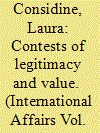

|
|
|
|
|
| Summary/Abstract |
The recently adopted Treaty on the Prohibition of Nuclear Weapons (TPNW) has caused much debate and controversy in global nuclear politics. Given that the stated goal of the TPNW supporters (states and NGOs alike) is to embed the treaty in the structures of nuclear governance and to strengthen its normative power, how likely is the TPNW to achieve these objectives? The article argues that the unique structures of legitimacy and value within which nuclear weapons are enmeshed place particular complications on the normative force of the TPNW as compared to previous humanitarian arms control initiatives, which has implications for the way in which the TPNW can function to consolidate a prohibitionary norm on nuclear weapons possession. The article uses the framing of legitimacy to analyse the complex structures within which the TPNW was adopted and within which it will enter into force, particularly focusing on the TPNW's relationship to the Treaty on the Non-Proliferation of Nuclear Weapons (NPT). The article concludes that consolidation may require a further challenge to the existing structures of nuclear order than state actors have, so far, been willing to make. This work is based on first-hand observations from the TPNW negotiations and interviews with civil society actors at the United Nations in New York in June and July 2017.
|
|
|
|
|
|
|
|
|
|
|
|
|
|
|
|
| 3 |
ID:
187386
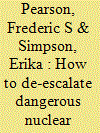

|
|
|
|
|
| Summary/Abstract |
Amidst the war in Ukraine, it is important to raise the prospect and vision of creating mutual security guarantees and ridding Europe of its dangerous nuclear weapon systems and provocative force deployments. In view of reckless Kremlin rhetoric and aggressive military action in Russia’s so-called near abroad, it is time for renewed approaches to arms control. As the Ukraine situation plays out, Russia, the United States, and allies in the North Atlantic Treaty Organization must return to their bargaining tables and negotiate strict limits, verification measures, and overarching controls over their nuclear use doctrines, weapon stockpiles, and conventional force deployments. All sides will have to make deep concessions and de-alert and de-operationalize mid- and short-range nuclear weapons while improving command and control safeguards—because, as we see, brandishing weapons and threatening escalation heightens tensions and increases the danger of crises spiralling uncontrollably.
|
|
|
|
|
|
|
|
|
|
|
|
|
|
|
|
| 4 |
ID:
160980
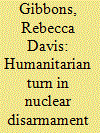

|
|
|
|
|
| Summary/Abstract |
On July 7, 2017, at the UN General Assembly, 122 states voted to adopt the Treaty on the Prohibition of Nuclear Weapons. This was the culmination of the work of a global network of states and grassroots activists that emphasized the devastating humanitarian consequences of nuclear-weapons use in order to delegitimize their possession. Advocates of the ban treaty are frustrated with the slow pace of nuclear disarmament through traditional channels. This article traces the history of the ban movement from 2005 to the present. It concludes by highlighting six factors that led to the successful adoption of the treaty: a small group of committed diplomats; an influx of new coalition members; the contribution of civil society; the reframing of the narrative surrounding nuclear weapons; the pursuit of a simple ban treaty; and the context provided by the Barack Obama administration.
|
|
|
|
|
|
|
|
|
|
|
|
|
|
|
|
| 5 |
ID:
160982
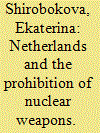

|
|
|
|
|
| Summary/Abstract |
On July 7, 2017, the United Nations conference to negotiate a legally binding instrument to prohibit nuclear weapons concluded with the adoption of the Treaty on the Prohibition of Nuclear Weapons (TPNW), which opened for signatures at the United Nations General Assembly two months later, on September 20. The nuclear-weapon states and their allies boycotted the negotiations with the sole exception of the Netherlands, which not only is a member of NATO, but also hosts US nuclear weapons on its territory. Domestic pressure and political traditions had significant effects on the Dutch government’s decision to participate in the ban negotiations. The Netherlands negotiated in good faith, but its multilateralism and humanitarian considerations could not tip the scales in favor of joining the ban treaty. The government’s commitment to a “step–by–step” approach to nuclear disarmament and maintenance of close cooperation with NATO determined the Dutch position on the new instrument. Despite staying outside the TPNW, the Dutch government shares the goal of nuclear-weapons elimination. This article also suggests a number of actions the Netherlands could take to advance nuclear disarmament.
|
|
|
|
|
|
|
|
|
|
|
|
|
|
|
|
| 6 |
ID:
160984
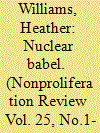

|
|
|
|
|
| Summary/Abstract |
The 2017 Treaty on the Prohibition of Nuclear Weapons has been successful in starting new conversations about nuclear weapons. Unfortunately, many of those conversations are happening in silos with ban supporters and opponents talking past each other. Both sides of the debate often misrepresent one another, putting at risk cooperation within the global nuclear order and progress toward the 2020 Nuclear Non-Proliferation Treaty Review Conference. To address these misperceptions, this article offers a bridge-building framework with steps for nuclear-weapon states, ban supporters, and regional and political coalitions. The framework is designed to be practical and to build trust following a heated and controversial debate around the ban treaty and its predecessor, the humanitarian impacts of nuclear weapons movement. The most important and timely of these efforts is for ban supporters and opponents to work together on risk reduction at a time of heightened geopolitical tensions with rising risks of misperception and inadvertent escalation.
|
|
|
|
|
|
|
|
|
|
|
|
|
|
|
|
| 7 |
ID:
161338
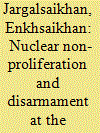

|
|
|
|
|
| Summary/Abstract |
Adoption of the Treaty on the Prohibition of Nuclear Weapons in July 2017 was a major event in the history of seven decades of policies and campaigns for non-proliferation and nuclear disarmament. In this, the role of non-nuclear weapon states (NNWSs) should not be underestimated. However, the treaty’s adoption would require bringing it into force by making use of the political momentum thus far generated. This will not be easy to do due to the position of the nuclear-weapon states and their allies. Hence, continued mutual support and cooperation among the NNWSs is vital, and working with the states under 'nuclear umbrella' will need to be pursued. The article also underlines the continued role of the civil society, both national and international, of nuclear weapon-free zones (NWFZs), and even of individual states contributing to practical nuclear disarmament. As an example of the latter, it examines Mongolia’s role and the challenges it faced when promoting its nuclear weapon-free status policy. The experience underlines the importance of greater understanding of the legitimate interests of each other and willingness to jointly address the issues of common concern, of working patiently in a low-key manner rather than pursuing immediate gains or headline-grabbing effects. The P5 joint declaration of 2012 regarding Mongolia’s status rules out using the country in future regional geopolitical rivalries and as such contributes to greater predictability, stability and confidence. The article also suggests the need for a renewed look at NWFZs from the perspective of twenty-first century technical developments and requirements.
|
|
|
|
|
|
|
|
|
|
|
|
|
|
|
|
| 8 |
ID:
160985
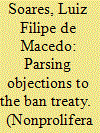

|
|
|
|
|
| Summary/Abstract |
The Secretary-General of the Agency for the Prohibition of Nuclear Weapons in Latin America and the Caribbean (OPANAL) rejects the argument of those opposed to the 2017 Treaty on the Prohibition of Nuclear Weapons that the treaty undermines the 1968 Treaty on the Non-Proliferation of Nuclear Weapons. This viewpoint is based upon Ambassador Soares’s statement to the conference, “Regional Consultations on the NPT: Towards the 2018 PrepCom,” held in Mexico City, February 15, 2018.
|
|
|
|
|
|
|
|
|
|
|
|
|
|
|
|
| 9 |
ID:
167794
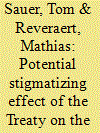

|
|
|
|
|
| Summary/Abstract |
On July 7, 2017, seventy-two years after the start of the nuclear era, 122 states concluded the Treaty on the Prohibition of Nuclear Weapons (TPNW, or “ban treaty”). The treaty forbids the development, production, acquisition, possession, transfer, testing, use, and threat of use of nuclear weapons. Advocates of the TPNW understand that it will not automatically lead to a world without nuclear weapons. The treaty’s main goal is to stimulate a societal and political debate inside the nuclear-armed states and their allies by strengthening the antinuclear norm and by stigmatizing nuclear weapons and their possessors. This article assesses to what extent this process of stigmatization might take place. It starts by elaborating on the concepts of stigma and stigmatization. It then matches the concept of stigma with nuclear weapons, and with the humanitarian initiative behind the momentum that led to the TPNW. The article concludes by looking to different stigma-management approaches that can be used by the nuclear-armed states and their allies.
|
|
|
|
|
|
|
|
|
|
|
|
|
|
|
|
| 10 |
ID:
185995
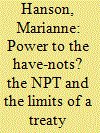

|
|
|
|
|
| Summary/Abstract |
The nuclear Non-Proliferation Treaty (NPT), its evolution over the past five decades, and the dissatisfaction of the non-nuclear states within it, can be analyzed by focusing on different understandings of power. Within the various concepts of power are claims which distinguish between what is known broadly as “power-over” and a more subtle form of influence, “power-to.” This article explores the history of the NPT, showing how the nuclear weapon states have shaped and limited this institution by practices which fall within the relational emphasis of “power-over.” Recently, however, non-nuclear states have adopted a “power-to” approach. Frustrated by their inability to bring about substantive change within the limits of the NPT, these states have realized and applied their agency and collective “power-to” in order to create an alternative approach to the problem of nuclear weapons in the context of the Treaty on the Prohibition of Nuclear Weapons (TPNW).
|
|
|
|
|
|
|
|
|
|
|
|
|
|
|
|
| 11 |
ID:
166860
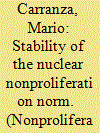

|
|
|
|
|
| Summary/Abstract |
This article argues that the nuclear nonproliferation norm (NNPN) is a social fact with a relatively independent life of its own and that it has a powerful impact on the behavior of both nuclear-weapon states (NWS) and non-nuclear-weapon states (NNWS). It challenges the application of critical constructivist research on norms to the NNPN and the idea that its legitimacy and structural power depend on contestation “all the way down.” State and non-state actors play an important role in explaining the dynamics of the NNPN, but agential constructivism runs the danger of “throwing the baby out with the bath water,” neglecting the structural impact of the NNPN on state behavior. The article examines the limitations of norm-contestation theory, arguing that some norms are more resistant to contestation than others. The NNPN is more difficult to contest than new norms (such as the Responsibility to Protect) because it is rooted in fifty years of nonproliferation nuclear diplomacy. The US-India nuclear deal is not a case of “norm change” but a violation of the NNPN. The “core” of the NNPN has not changed since the US-India nuclear deal. The conflict confronting NWS and NNWS is about the implementation of “type 2” norms (organizing principles) and “type 3” norms (standardized procedures), and not about the “hard core” of the NNPN.
|
|
|
|
|
|
|
|
|
|
|
|
|
|
|
|
| 12 |
ID:
167948
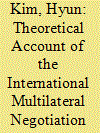

|
|
|
|
|
| Summary/Abstract |
This article aims to explain the multilateral negotiations of the Treaty on the
Prohibition of Nuclear Weapons, which was adopted at the UN General Assembly
on July 7, 2017, from the model of institutional bargaining. Its findings are: first,
non-nuclear states’ sense of frustration and crisis about the failure of progress on
nuclear disarmament under the NPT regime served as a critical momentum to move
towards the negotiations. Second, consensual knowledge about the humanitarian
effects of nuclear weapons and solutions served as a driving force behind
embarking on the negotiations. Third, the leadership by a core group of pro-ban
non-nuclear countries was effective in mobilizing political support and facilitating
the timely conclusion of the negotiations. Fourth, a salient solution of a simple
and robust treaty, and a bridging solution to allow any country in possession of
nuclear weapons to join the treaty before their elimination contributed to the prompt
agreement on the treaty. Fifth, clear and effective compliance measures regarding
non-nuclear states facilitated the conclusion of the negotiations, whereas the lack
of clear and effective compliance measures regarding state parties possessing
nuclear weapons rather contributed to the timely end of the negotiations. Finally, a
fast-track approach, a single-text negotiating strategy, and an issue decomposition
strategy were effective in reaching consensus on the treaty text.
|
|
|
|
|
|
|
|
|
|
|
|
|
|
|
|
| 13 |
ID:
187495
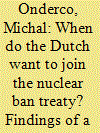

|
|
|
|
|
| Summary/Abstract |
Even if most European countries have not yet joined the Treaty on the Prohibition of Nuclear Weapons (TPNW), the treaty has been salient in a number of national settings. In the Netherlands, the TPNW enjoys broad societal appeal, and the Dutch parliament has, on a number of occasions, called on the government to explore options for joining the treaty. In this piece, we empirically study Dutch attitudes toward joining the TPNW. Our findings indicate that a majority of the Dutch would prefer to accede to the TPNW only if nuclear-weapon states or other NATO allies also joined, although unilateral accession received relatively strong support among the youngest respondents, women, and voters supporting the left-wing parties. The most popular option is to join the TPNW at the same time that the nuclear-weapon states do, which seems to be a rather distant prospect in the current international-security environment.
|
|
|
|
|
|
|
|
|
|
|
|
|
|
|
|
| 14 |
ID:
185998
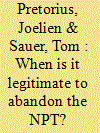

|
|
|
|
|
| Summary/Abstract |
Treaties can be denounced and withdrawn from unilaterally and collectively. We ask when it would be legitimate to abandon the NPT, a treaty that 50 years ago committed states to nuclear non-proliferation and disarmament, but still has not delivered on the latter. The end of the NPT is a taboo subject in the arms control community that sees it as the cornerstone of the nuclear order. We draw on literature on the legitimacy of and exit from international institutions. We especially explore the political substance of the discontent that the non-nuclear weapons states have expressed in and outside the NPT forum. Exiting the NPT can legitimately be used as a political tool to challenge the current status quo where five states claim a right to possess nuclear weapons based on the NPT, and to achieve a nuclear order where nuclear weapons are illegal for all.
|
|
|
|
|
|
|
|
|
|
|
|
|
|
|
|
|
|
|
|
|